Global high-mix volume high-speed PCBA manufacturer
9:00 -18:00, Mon. - Fri. (GMT+8)
9:00 -12:00, Sat. (GMT+8)
(Except Chinese public holidays)
Global high-mix volume high-speed PCBA manufacturer
9:00 -18:00, Mon. - Fri. (GMT+8)
9:00 -12:00, Sat. (GMT+8)
(Except Chinese public holidays)
HomePage > Blog > Knowledge Base > What Is A Silicon Control Rectifier
The SCR, or silicon-controlled rectifier, is an electronic component that is used in different electronic circuits and devices as switches. It is structured with 3 terminals that help to control the magnitude and direction of current flowing in the circuit. Its common uses are in industries for different circuits, such as lighting circuit controls, motor speed control, and high-power transmission lines.
Silicon is commonly used for the creation of different semiconductor components, and SCR is also made with this material. It is mainly used for rectifier circuits, which means AC to DC conversion, so it is known as a controlled rectifier. In this tutorial, we will discuss its working, features, applications, and other features. Let's get started with.
The SCR is a semiconductor device that is used as a switch to control AC or DC flow in circuits. It has a 4-layer structure that is configured as a PNPN combination. In this PNPN, there are 3 PN layers. Its design is such that when no power supply is connected to its terminal, it works as an open switch. If the positive lead of the power source is connected with the gate terminal of the SCR, as a result of a small current, the SCR starts operating and the current passes through it. The current continues to flow until the power is disconnected. SCR was first made by General Electric (GE) in 1957. At that time, it was known as an SCR or silicon-controlled rectifier; it was also known as a thyristor.
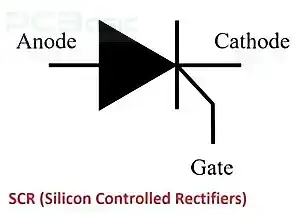
SCR stands for silicon-controlled rectifiers, and it is a four-layer semiconductor material-configured device.
Discrete Plastic:
It is a very commonly used type of SCR and has 3 pinouts that are configured with plastic-coated semiconductor material. This SCR has planer designs and has a lower cost than other types. It is used for 25-volt to 1000-volt applications. It has space for connection, so larger components of circuits.
Plastic Module:
It comes with more than one device, has a current range of about 100 ampers, and has the same features as a discrete plastic type. It is connected to a printed circuit board by bolting the heatsink.
Press Pack:
This type of SCR is used for high-current projects such as 200 Amperes of current or higher and a voltage value of 1200 volts or higher. Its inner structure is converted with ceramic casing and has separation or insulation between the cathode and anode.
Stud Base:
Stud-base SCRs come with screwed bases and supports five to 150 amperes of current through the use of a complete voltage range. They have low thermal resistance and can efficiently dissipate heat. They are mechanically attached to the heatsink, making them more difficult to remove
Flat Base:
It comes with a separation from the heatsink with the use of insulation, and its features are like stud-base SCR. Its current range is 10 to 400A.
For finding the VI characteristics of SCR, 3 operating regions are used: forward block, forward conduction region, and reverse block region.
There is a small leakage current flowing in the reverse direction for reverse blocking mode that is seen on the negative side of the graph.
For forward blocking mode, the anode is positive supply connected and the cathode is negative. As a result, a small leakage current passes through the SCR in a positive direction, and the graph is in a positive direction.
After reaching a certain voltage level, which is known as breakdown voltage, the SCR is in conductive mode with high current flow.
The gate current in the graph is devoted to I1, I2, and I3, and for high gate current, high conduction will be of SCR.
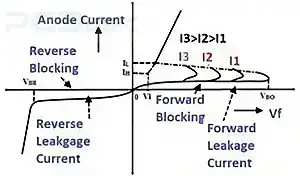
The symbolic representation of Silicon Rectifiers is like a diode. That means it has a diode and cathode-like diode with additional terminal gates. SCR allows current to flow in one direction and stops in the reverse direction. Its 3 terminals are anode, cathode, and gate, which are denoted as A, K, and G, respectively. Gate terminals are used as control points and are on or off the SCR.
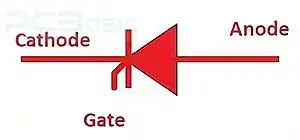
As mentioned above, we discussed that SCR has 4 layers that can be in combination with PNPN or NPNP. In these four layers, 3 PN junctions are denoted as J1, J2, and J3. Its anode is a positive terminal, that is the P layer, and the cathode is a negative electrode, that is the N layer. Gates are used for controlling the SCR.
Its P and N layers with 3 electrodes are highly doped, and the middle P and N layers are less doped, and the gate is configured with a P layer. An SCR comes with 3 types of construction: Mesa, Planar, and Press Pack
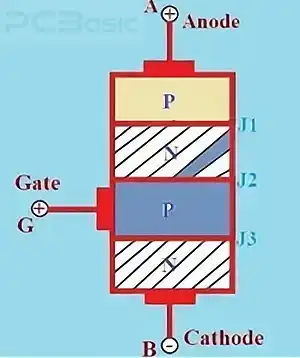
SCR working is like a diode, which means it allows current to flow in the forward direction and block in the reverse direction. It has features for handling high voltages.
Its gate controls the flow of positive forward current in the anode. The application of a short pulse at the gate allows SCR to work between the anode and the cathode. As a result, anode current flows become zero when SCR is off. For again, the condition of the voltage gate gets another pulse.
There are 3 main working modes of operation of SCR.
Forward Blocking Mode
● Positive voltage is connected to the anode and negative at the cathode. In forward blocking mode, J1 and J3 are forward-biased, and J2 is reverse-biased. This prevents current from flowing until the gate triggers conduction.
Forward Conduction Mode
● In this mode, SCR will be on state and operate. There are 2 methods for the conduction of SCR. The first one is higher forward-biased voltage as compared to breakdown or providing a positive supply at the gate terminal.
Reverse Blocking Mode
● The positive terminal of the battery has a cathode and the negative with the anode of the SCR. When voltage is provided, Junctions J1 and J3 are working as reversed biased and J2 is forward biased.
● It is used as a rectifier and switched from AC to DC conversion.
● It is used for high-power handling and current circuits and easily turns off with low voltage.
● It is used in power supply circuits and motor speed controllers.
● It is used for voltage regulator circuits to provide constant voltage for the device working.
The SCR is now an important semiconductor device that is used for different electronic projects and circuits. It is the main component for power-handling circuits and is mostly used for the electrical system. It is also used for managing components working from overvoltages and is mostly used in rectifiers. It needed voltage work, and its 3 modes make it a complicated device for working in circuits. SCR is mostly used as compared to members of thyristor groups such as DIAC or TRIAC. Its high current handling features help it be used for applications where high current is involved, like welding devices and large inverters.
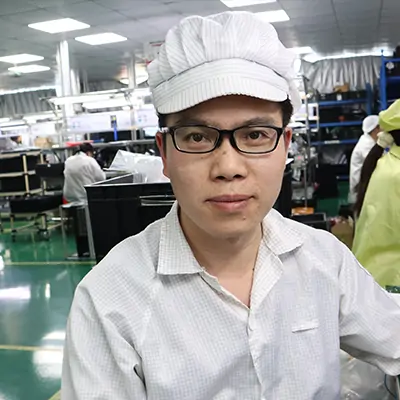
Assembly Enquiry
Instant Quote
Phone contact

+86-755-27218592
In addition, we've prepared a Help Center. We recommend checking it before reaching out, as your question and its answer may already be clearly explained there.
Wechat Support

In addition, we've prepared a Help Center. We recommend checking it before reaching out, as your question and its answer may already be clearly explained there.
WhatsApp Support

In addition, we've prepared a Help Center. We recommend checking it before reaching out, as your question and its answer may already be clearly explained there.
